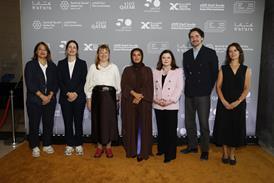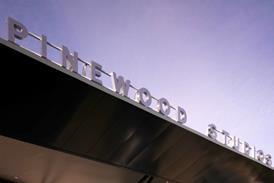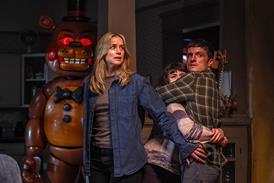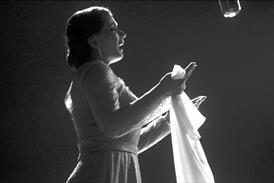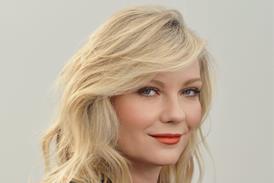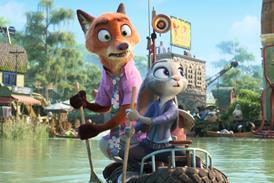Athina Rachel Tsangari’s film is a textured adaptation of a novel set in a 17th century Scottish village

Dir: Athina Rachel Tsangari. UK/Germany/Greece/France/US. 2024. 133mins
The characters in Athina Rachel Tsangari’s visceral, earthy adaptation of Jim Crace’s 17th-century set novel live closer than most to the dirt. They are covered in it for a start: filth clings to them, crusted under nails and ground into pores. Peasants in a small, unnamed village which is “two days by post-horse, three days by chariot” from anything resembling a market town, they are dependent on the soil for survival – on common grazing rights and on what they can glean from the ground following the harvest – and on the benevolence of the local landowner, Master Kent (Harry Melling). Yet the arrival of three sets of strangers signals a seismic shift from the village’s pre-industrial way of life, and Tsangari captures the upheaval vividly.
There’s a wildness and a pagan spirit to the film’s energy
Nearly a decade has passed since Tsangari’s last film, Chevalier, premiered in Locarno and went on to win numerous prizes, including in London, Thessaloniki and Sarajevo. Before that, her previous picture, Attenberg, launched in Venice in 2010, where it added momentum to the Greek Weird Wave, won the Volpi Cup for actress Ariane Labed and the Lina Mangiacapre Award for Tsangari. Harvest, however, is a world apart from the crisp, cruel contemporary commentary of the director’s previous works. There’s a wildness and a pagan spirit to the film’s energy. At times, it feels like a painting of a peasant bacchanale in all its grubby, profane glory. It’s a film about the unravelling of a way of life; as such, it can feel that some of the power dissipates as this small community disintegrates. Even so, this is pungent filmmaking which creates a world steeped in superstition, ritual and folk-magic.
Our guide to village life is Walter Thirsk (Caleb Landry Jones), a watchful, quiet man who exists on the edge of the community, the exact location of which is never specified - although accents and mention of a Loch suggest Scotland (where the film shot). He was not born within the stone boundaries that mark the land (a deliciously odd scene shows a ritual in which the heads of the village kids are vigorously bumped on the boundary rocks so that they know where they belong), but arrived with Master Kent as a friend and manservant.
There’s a grudging acceptance of both Walter and Kent – both were married to local lasses, both were subsequently widowed. But while Kent needily clings to Walter for emotional support, Walter enjoys the respect of the community and has a sporadic, secret relationship with Kitty Gosse (Rosy McEwen). But the allegiances and tensions in the village can change as suddenly as the highland weather.
The first of the strangers, two men and a woman, arrive just after the master’s stable has been burned. And while Walter, and presumably most of the other villagers, know that the culprits were the bored young village bachelors, hopped up on shrooms plucked from the heath, it suits them to blame the strangers for the arson. Another newcomer is more warmly welcomed, initially at least: Mr Earle, known as Quill (Arinzé Kene), has been summoned by the master to map the land. Walter is fascinated by the man and his work, and shares with him his knowledge of the local flora and fauna: “Everything here will either give you the shits or keep you from getting them,” he explains pithily. The final arrival is that of Kent’s cousin Master Jordan (Frank Dillane), who turns up with his retinue and designs on the estate.
The feral spirit of the world is gorgeously evoked throughout, with Sean Price-Williams’ cinematography a standout. Price-Williams, shooting on film, embraces the organic qualities of the medium: the edge of the frame is ragged and mossy; he makes a virtue of the grain and the characterful imperfections in the image. Like the photography, the costumes also have a frayed, rough-hewn quality, and a pleasing palette of faded indigos and the red of dried ox blood. On special occasions – the riotous harvest celebration for example – the villagers put on animal masks, and behave accordingly.
And music is part of the tapestry of life: the women sing hauntingly lovely traditional Scottish folk songs then the fiddles whip up a frenzy of boisterous bad behaviour once the work is done. It’s all so fully-realised, so vibrant, that it almost comes as a shock once we realise just how precarious is the grip on the land and this way of life.
Production company: Harvest Film Ltd, Sixteen Films Ltd, The Match Factory, Haos Film, Louverture Films, Why Not Productions
International sales: The Match Factory sales@matchfactory.de
Producers: Rebecca O’Brien, Joslyn Barnes, Michael Weber, Viola Fügen, Athina Rachel Tsangari, Marie-Elena Dyche
Cinematography: Sean Price-Williams
Editing: Matt Johnson, Nico Leunen
Production design: Nathan Parker
Music: Nicolas Becker, Ian Hassett, Caleb Landry Jones, Lexx
Main cast: Caleb Landry Jones, Harry Melling, Rosy McEwen, Arinzé Kene, Thalissa Teixeira, Frank Dillane




